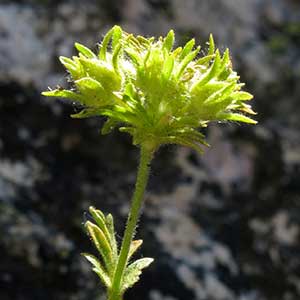Ivesia longibracteata
Ivesia unguiculata
Castle Crags ivesia, longbract mousetail
Yosemite ivesia, Yosemite mousetail
ascending to erect, 0.3–1.2 dm.
decumbent to ascending, 1–3.5 dm.
weakly planar to loosely ± cylindric, (0.5–)2–4(–6) cm; sheathing base glandular abaxially, otherwise glabrous;
petiole 0.5–2 cm, hairs 0.2–1 mm;
leaflets 5–6 per side, 2–6 mm, ± short-hirsute, glandular-puberulent, lobes 2–7, oblanceolate to spatulate or obovate, apex not setose.
(4–)7–15 cm; sheathing base ± glabrous abaxially;
stipules linear, 3–6 mm;
petiole (0.3–)0.5–4(–5) cm, hairs sparse to abundant, ascending to spreading, 1–2 mm;
leaflets 15–20(–25) per side, loosely overlapping, 3–6 mm, lobes 3–8, linear to oblanceolate, hairs sparse to abundant, spreading, 1–2 mm.
1–3, not paired.
3–6.
3–14-flowered, 1–2.5 cm diam.;
glomerules 1.
(15–)30–100(–200)-flowered, (1–)1.5–4(–8) cm diam., flowers mostly arranged in 1–several loose to tight glomerules of 5–10 flowers.
1.5–6 mm.
1–3 mm.
8–10 mm diam.;
epicalyx bractlets linear to narrowly lanceolate or elliptic, 2.5–5 mm, longer than sepals;
hypanthium shallowly cupulate, 0.5–1 × 2–3 mm;
sepals 1.5–2.5 mm, ± acute;
petals pale yellow, linear to narrowly oblanceolate, 1.5–2.5 mm;
stamens 5, filaments 0.7–1.3 mm, anthers yellow, 0.5–0.8 mm;
carpels 6–11, styles 1–1.5 mm.
6–9 mm diam.;
epicalyx bractlets linear or narrowly lanceolate to elliptic or narrowly oblong, 1.2–2(–3) mm;
hypanthium shallowly turbinate, 1.5–2.5 × 2–3(–3.5) mm, often nearly as deep as wide;
sepals heavily purple-mottled, (1.5–)2–3(–3.5) mm, acute;
petals white, often tinged with pink, oblanceolate to spatulate or obovate, 3–4 mm;
stamens 10–15, filaments filiform, 0.6–1.1 mm, anthers maroon, 0.3–0.5 mm;
carpels (1–)3–9, styles 1.4–2 mm.
cream to light tan, 1.2–1.5 mm.
light brown, 1.2–1.5 mm.
Ivesia longibracteata
Ivesia unguiculata
Of conservation concern.
Ivesia longibracteata is known only from the Castle Crags area of Shasta County. The epithet alludes to a diagnostic characteristic unique in the genus: the epicalyx bractlets are longer than the sepals. The plants grow on vertical rock faces, a habitat more characteristic of sect. Setosae; however, the stems are ascending to erect and do not form hanging clumps, and the pedicels are not curved in fruit.
(Discussion copyrighted by Flora of North America; reprinted with permission.)
Of conservation concern.
Ivesia unguiculata is found in mid-elevation meadows of the central Sierra Nevada, mostly north of the Kings River. The distinctive deep red to purplish coloration of the inflorescence, and the plant in general, can make patches of this species conspicuous as a smoky purplish haze in meadows. The shape and color of the inflorescences are similar to those of the sympatric Horkelia fusca var. parviflora, suggesting shared pollinators.
The description and illustration by J. D. Hooker (1881), supposedly of Potentilla (Ivesia) unguiculata, were based actually on material grown from seed of I. sericoleuca due to initial confusion of the two species (W. H. Brewer et al. 1876–1880, vol. 1).
The type (Kellogg s.n., CAS) of Potentilla ciliata Greene (not Rafinesque) is unquestionably this species; however, the purported locality (Owens Valley, Inyo County) is dubious and most likely an error in the labeling of the specimen by the collector.
(Discussion copyrighted by Flora of North America; reprinted with permission.)


